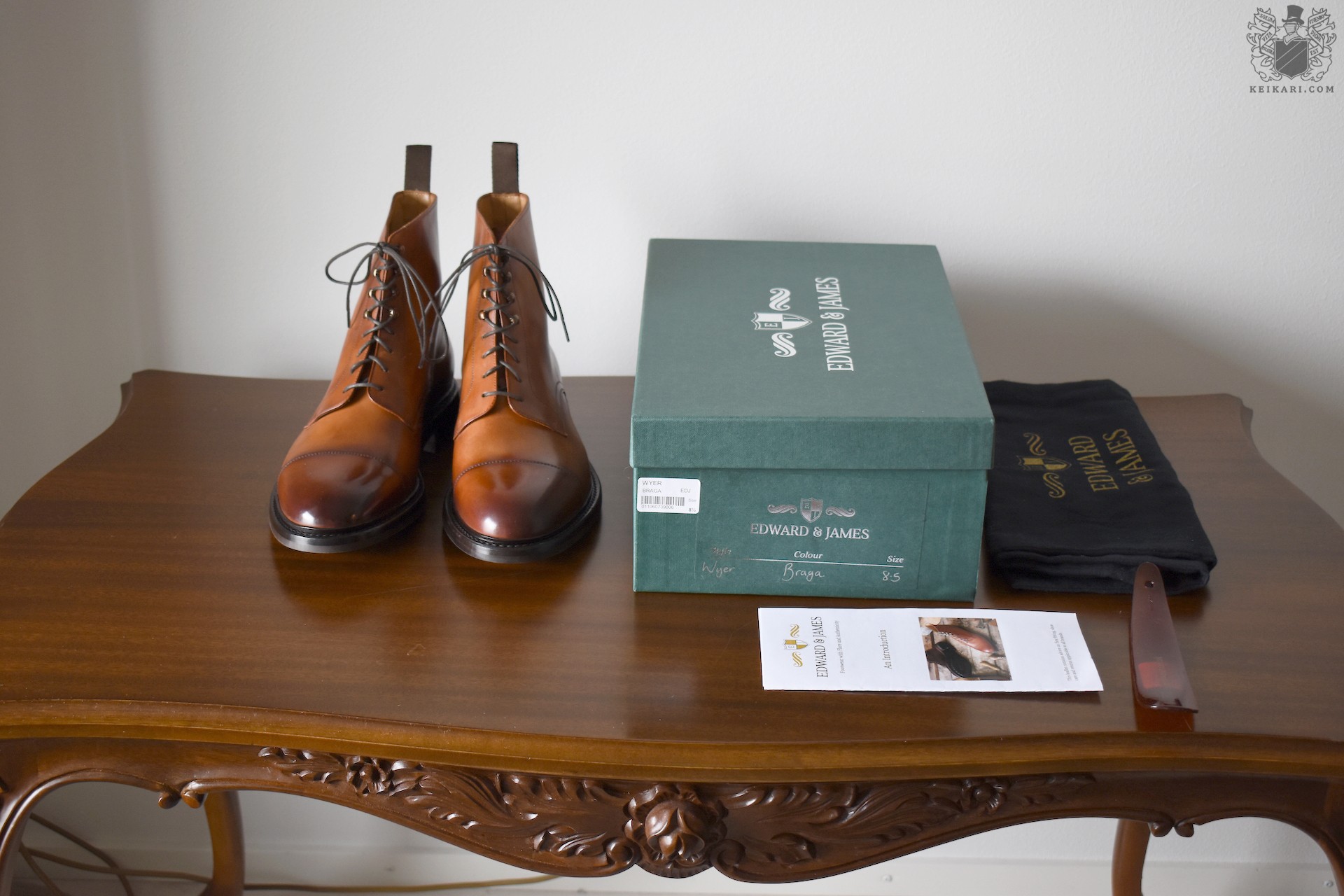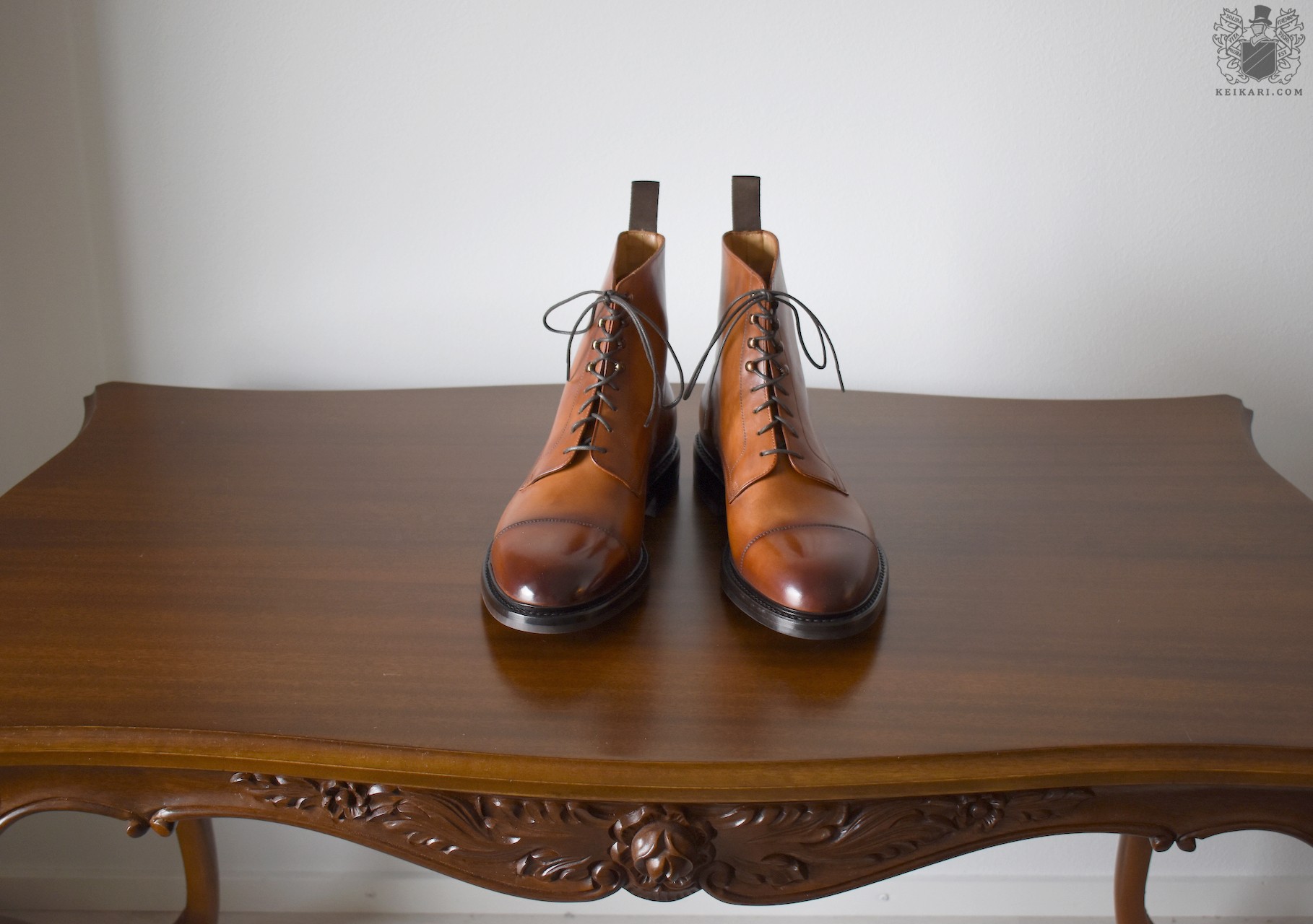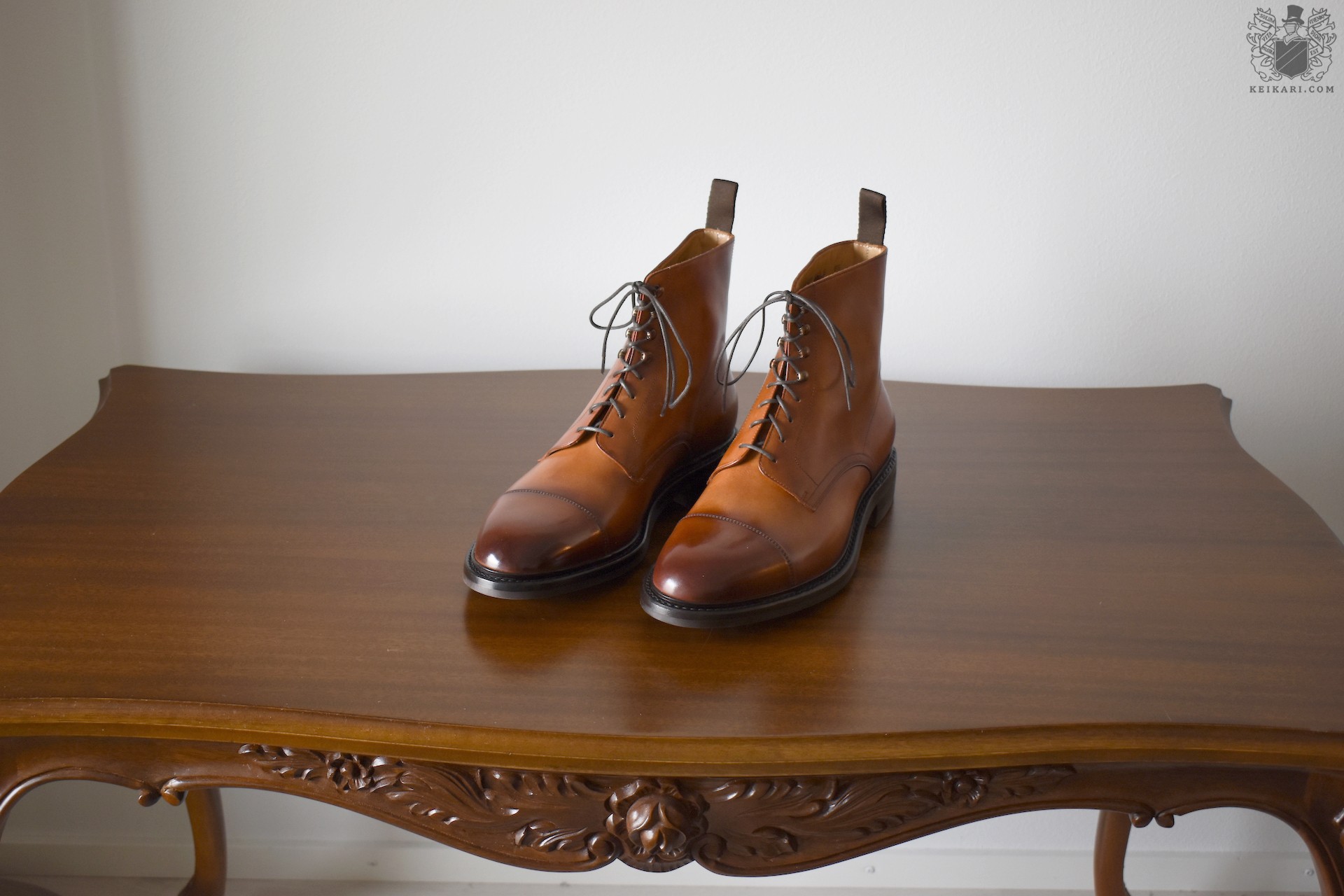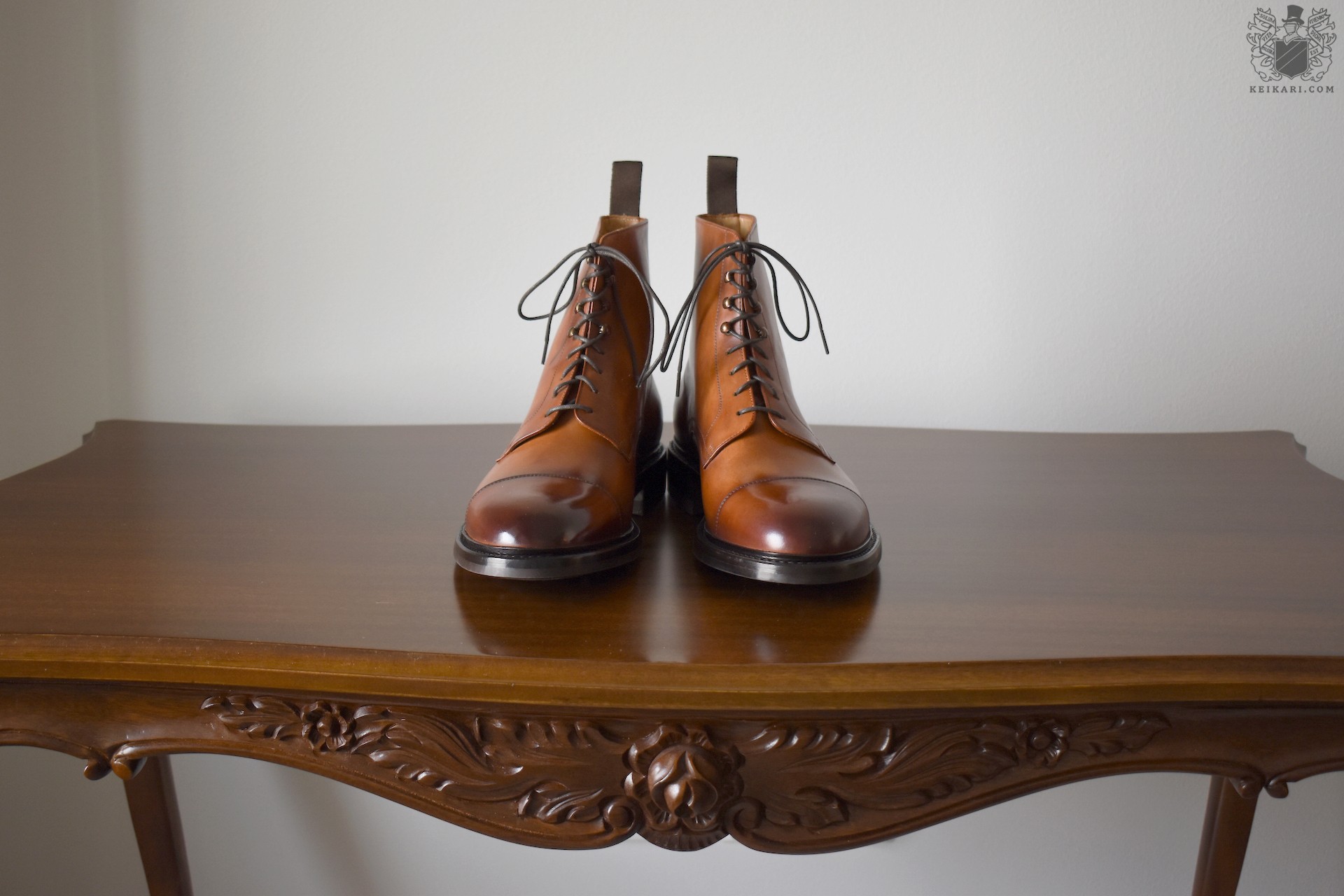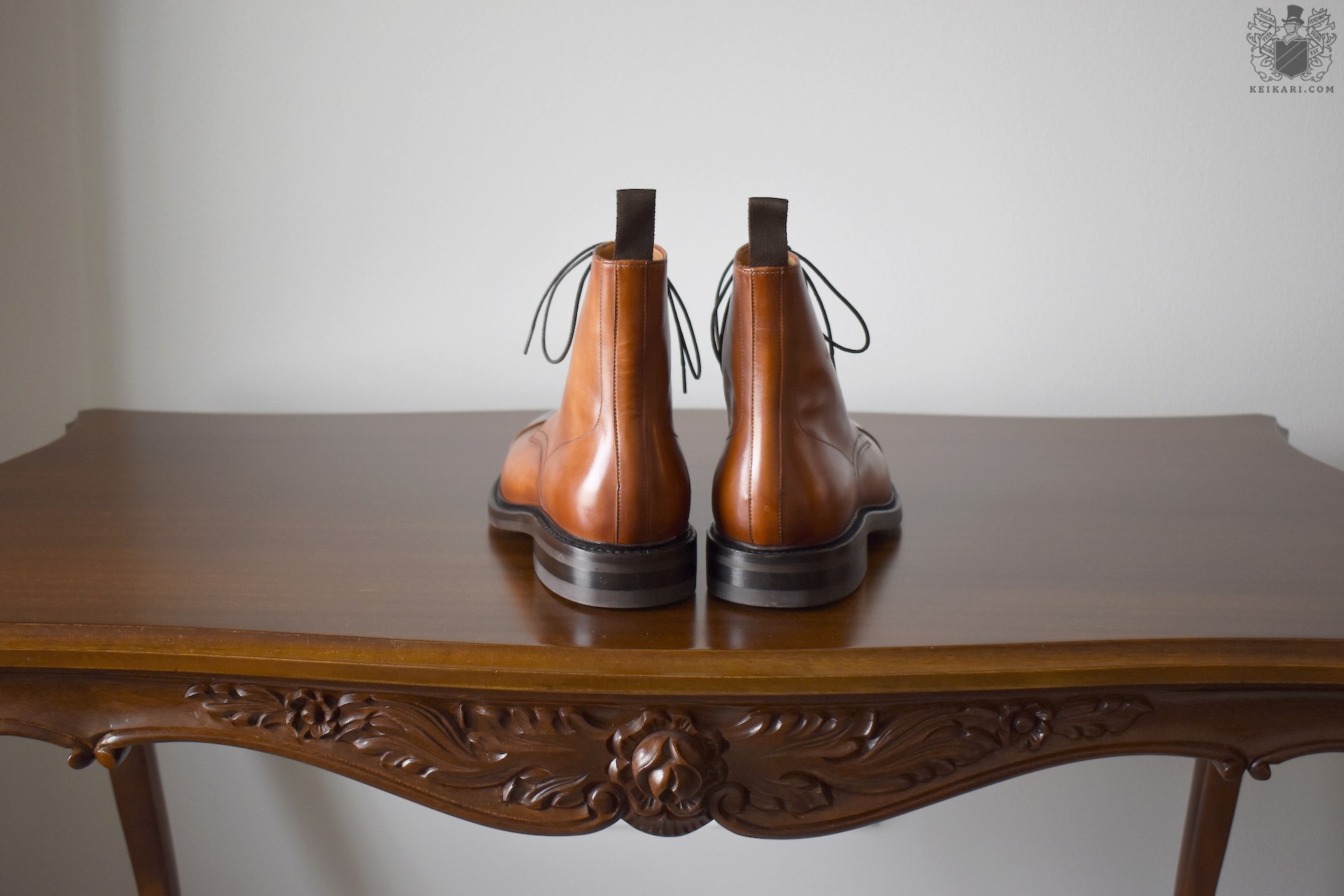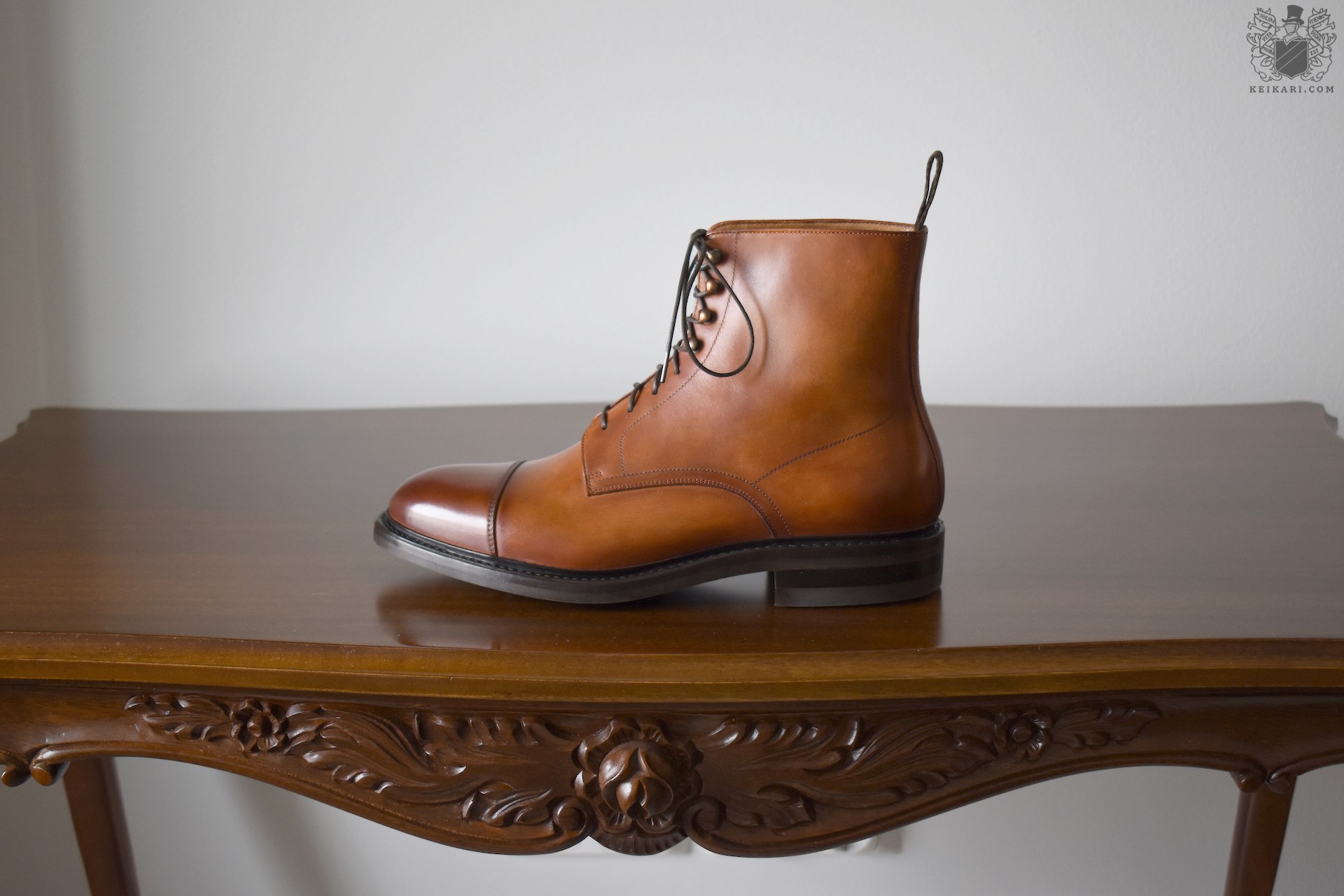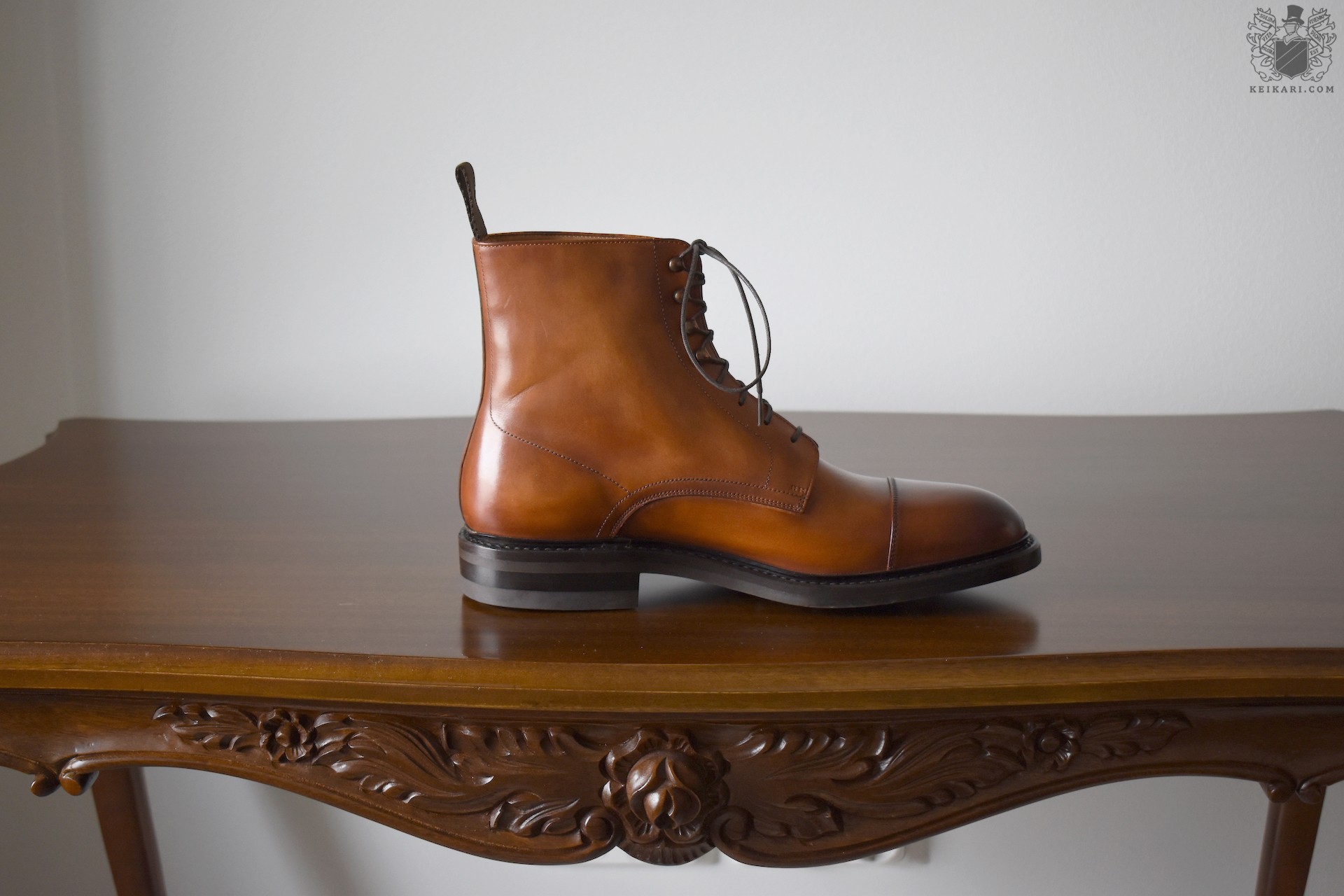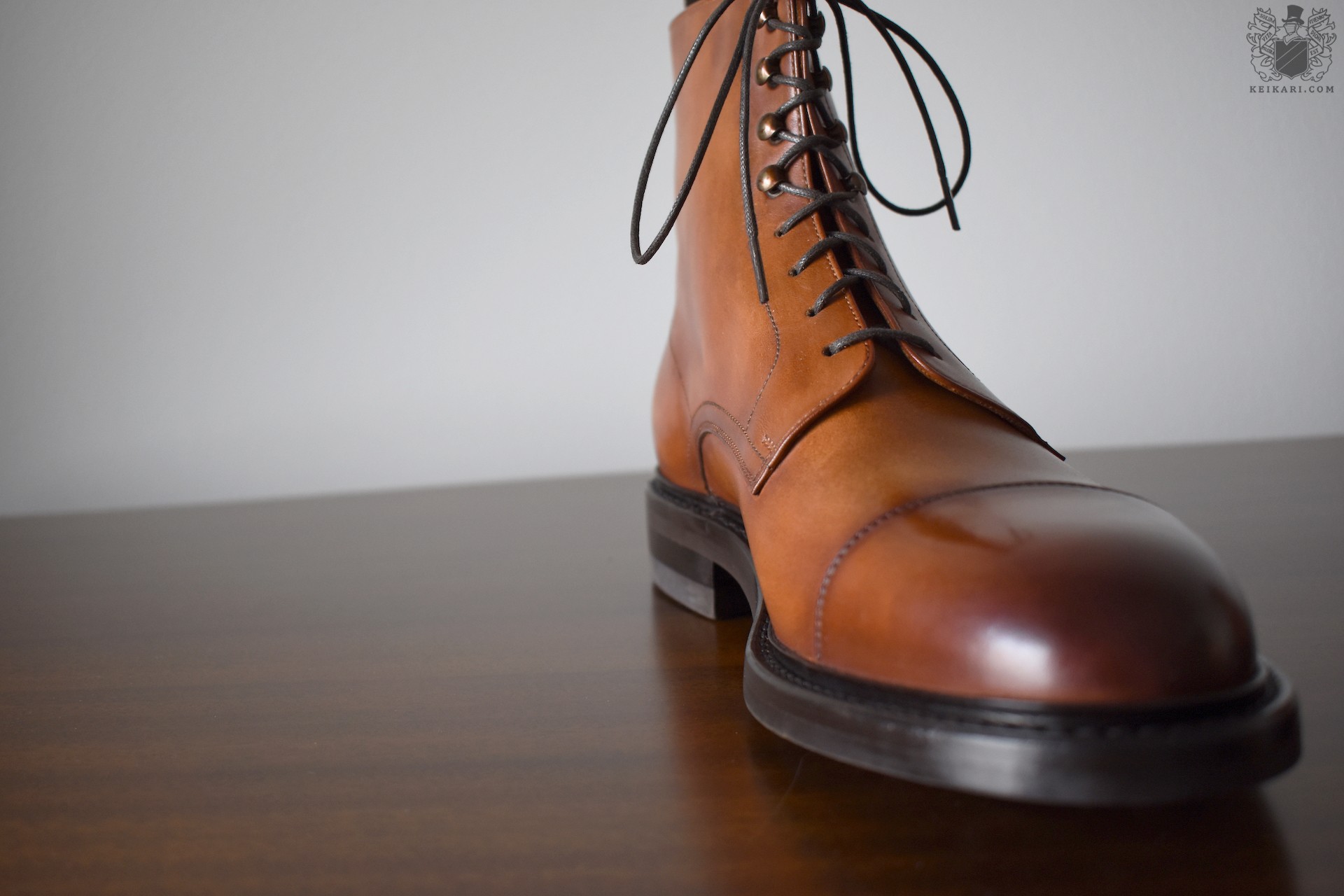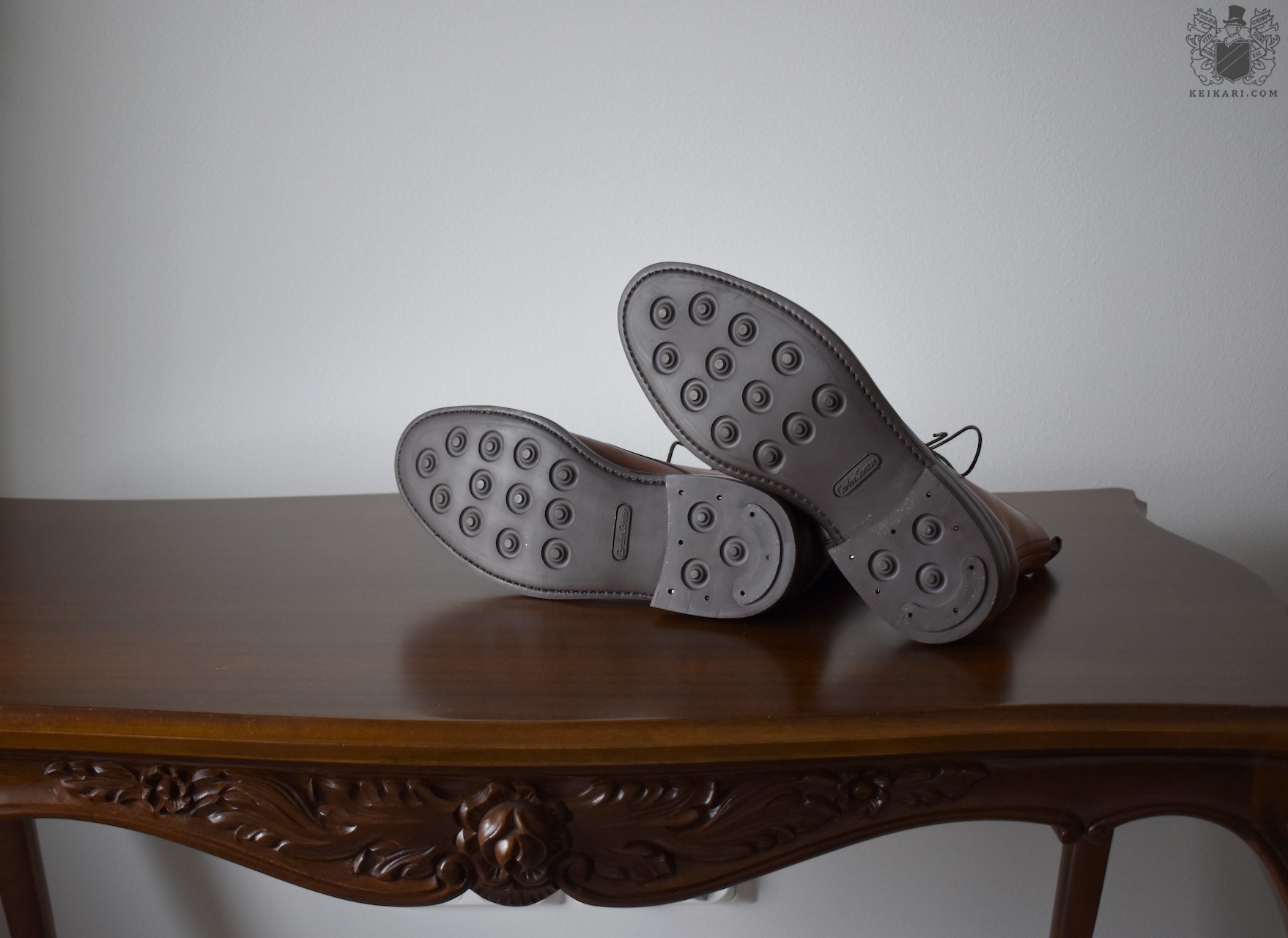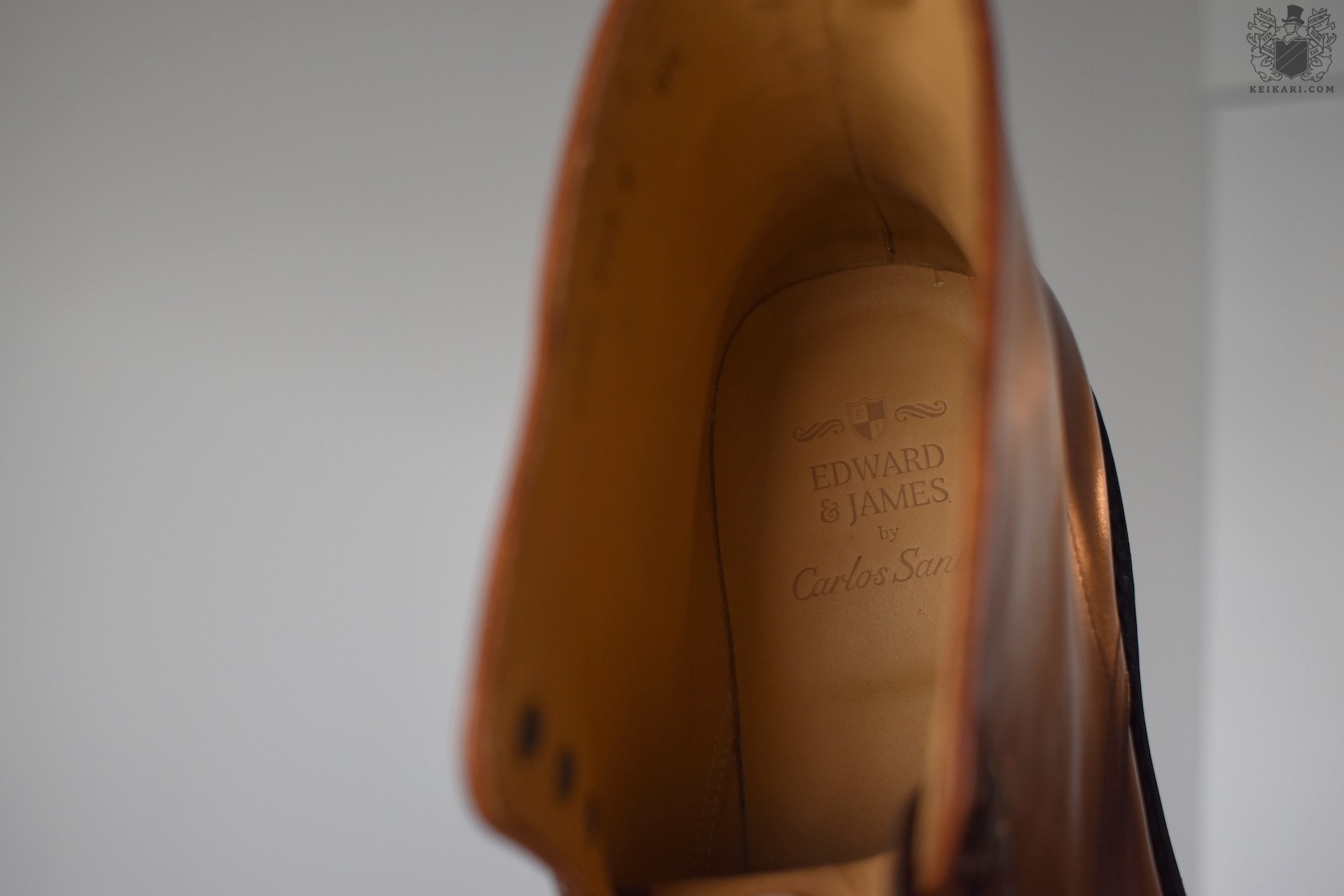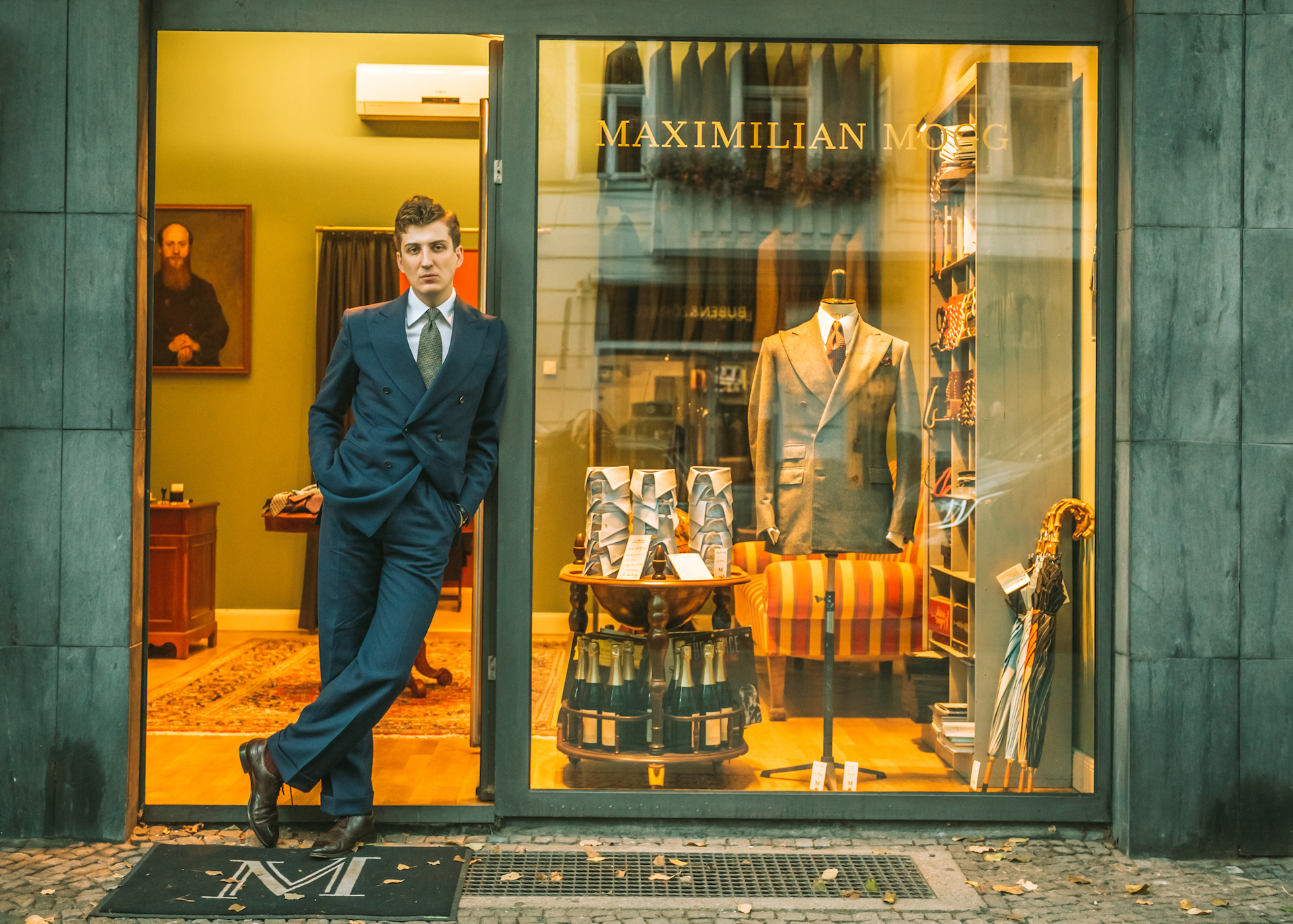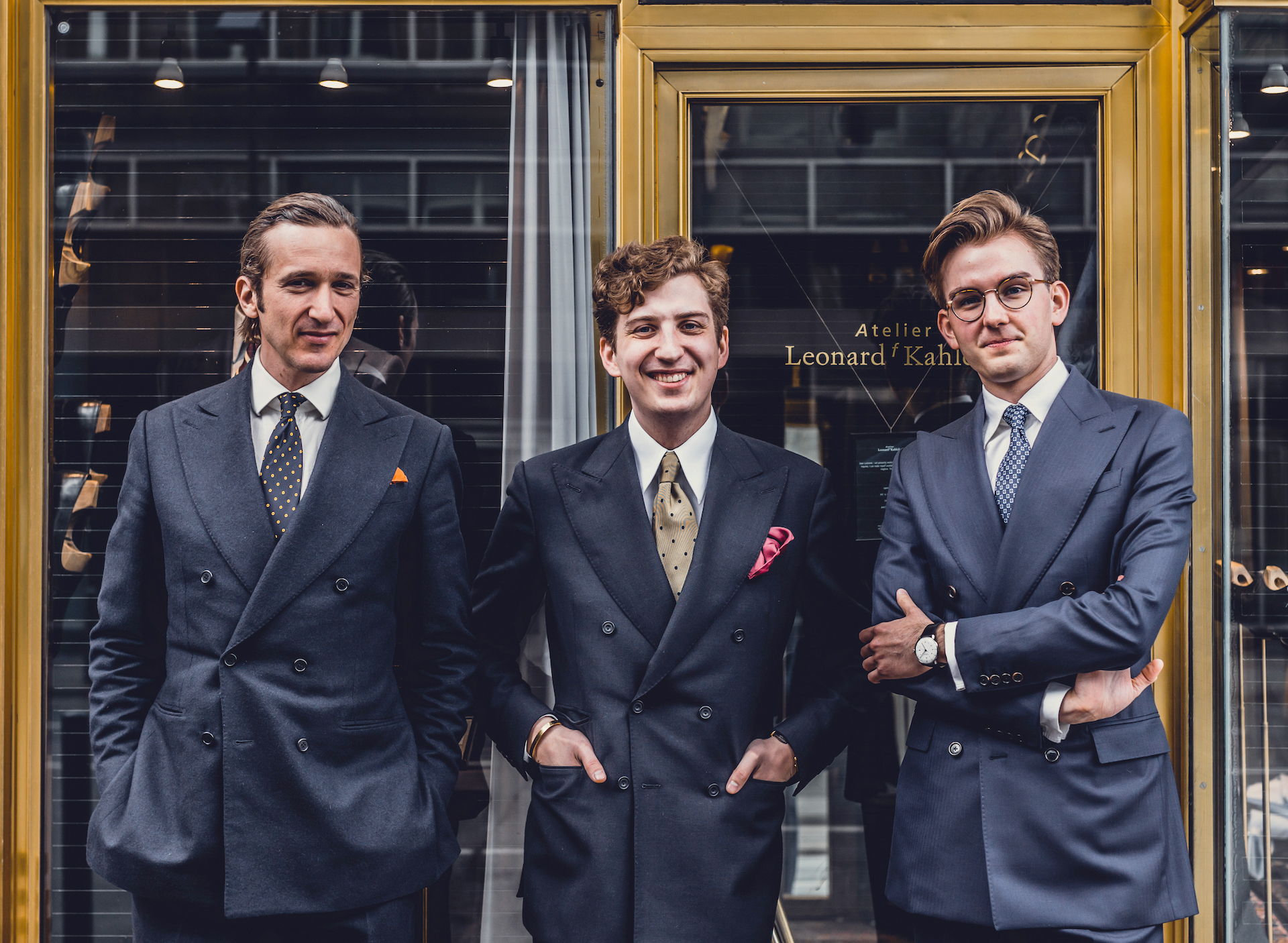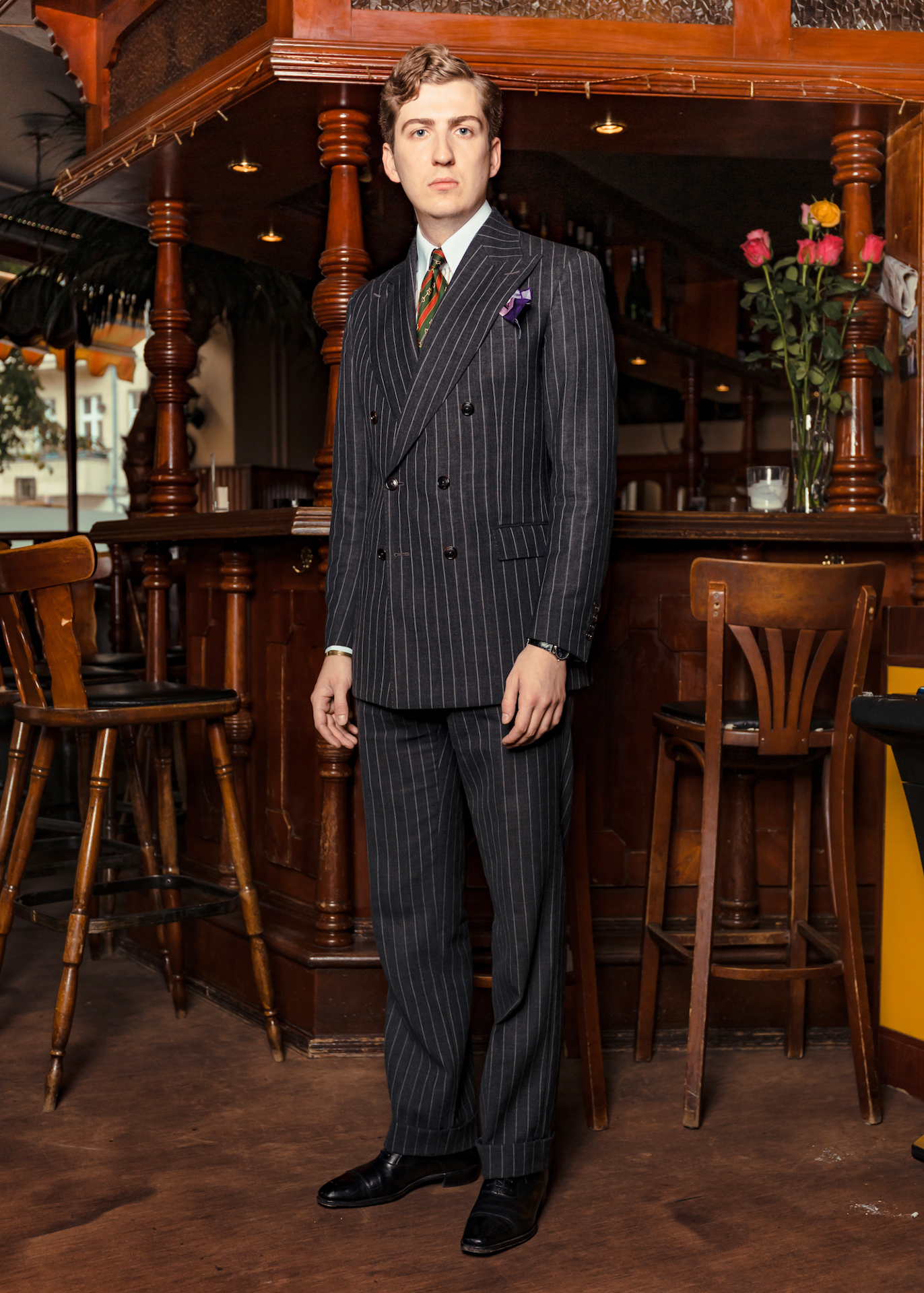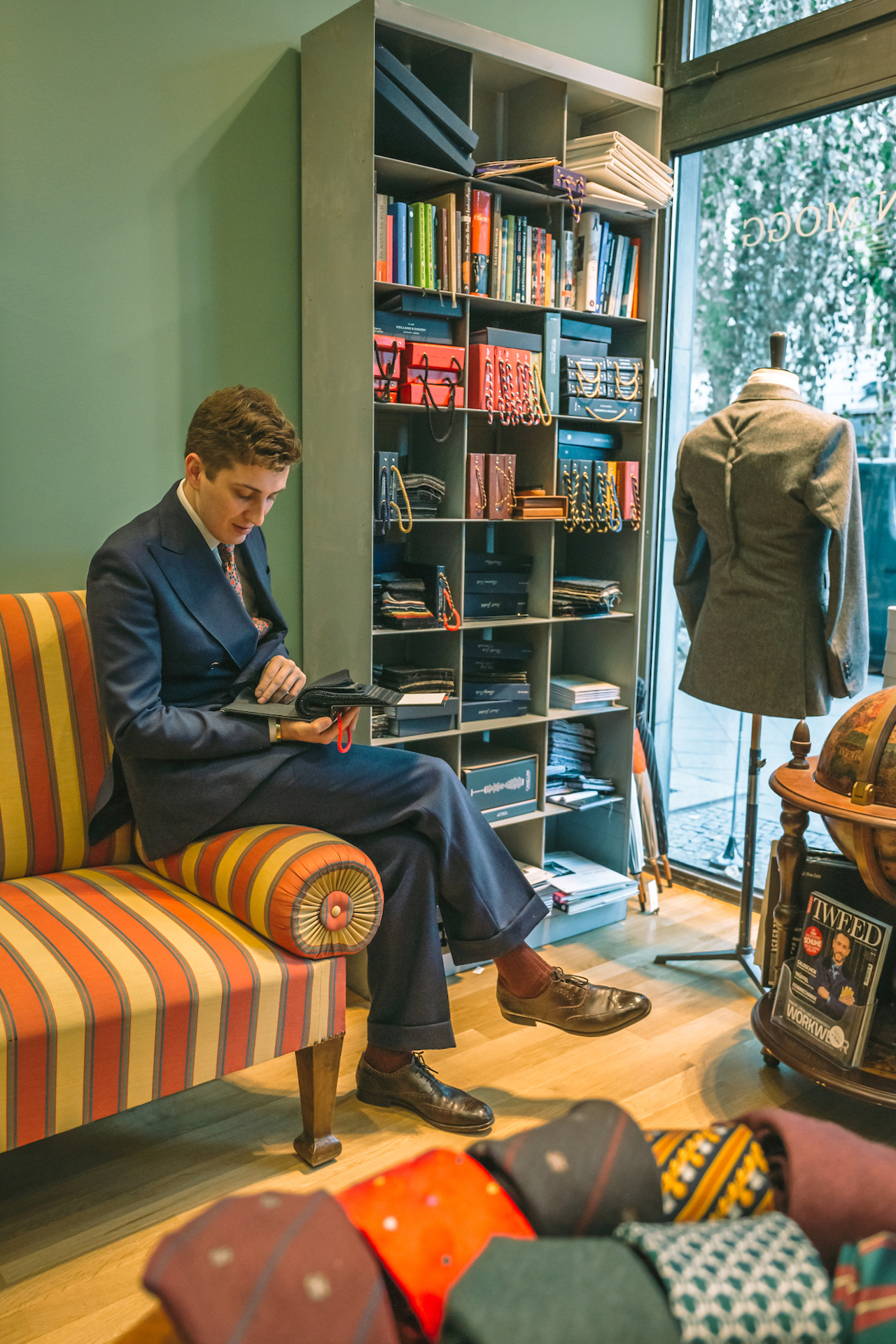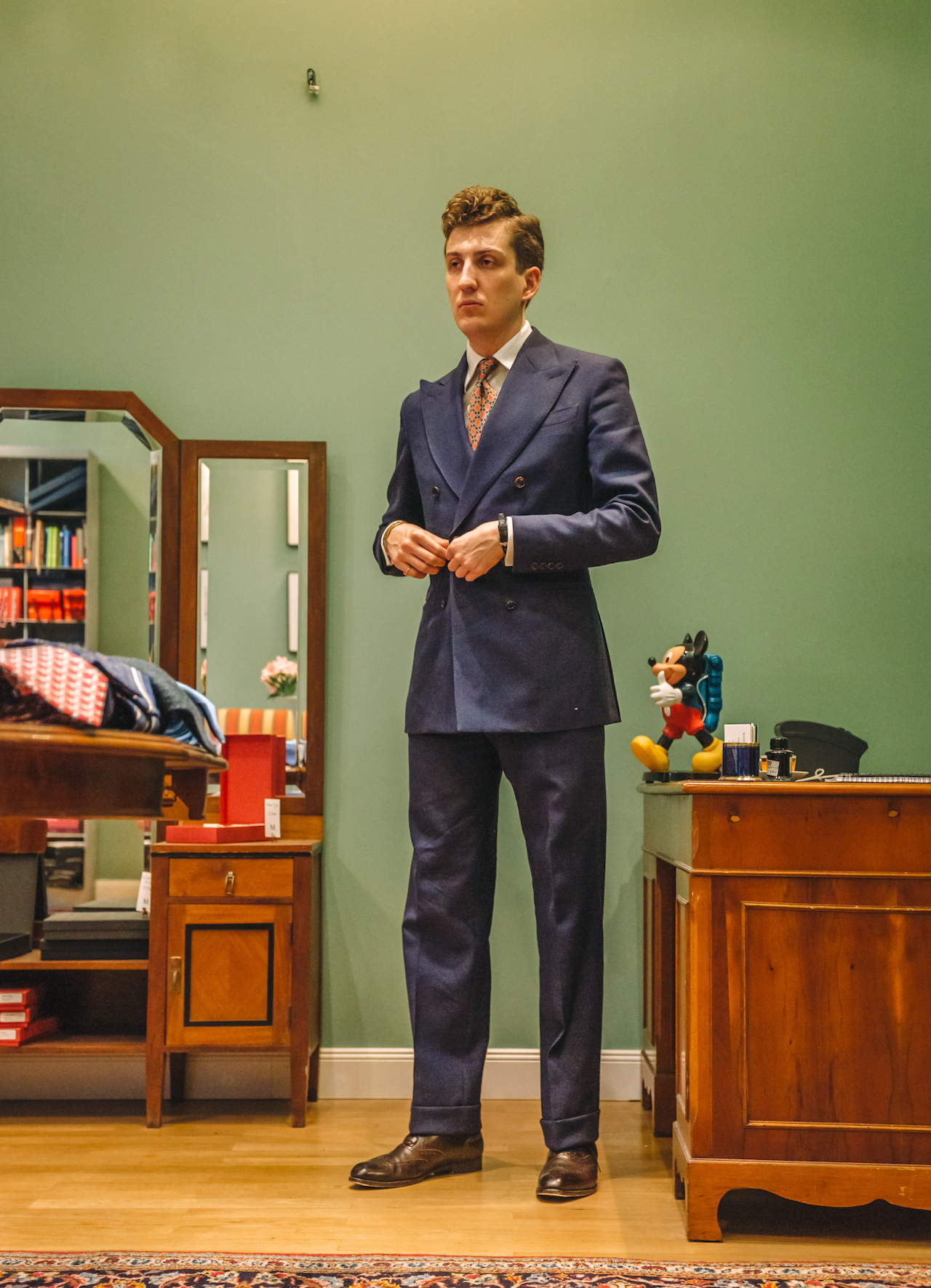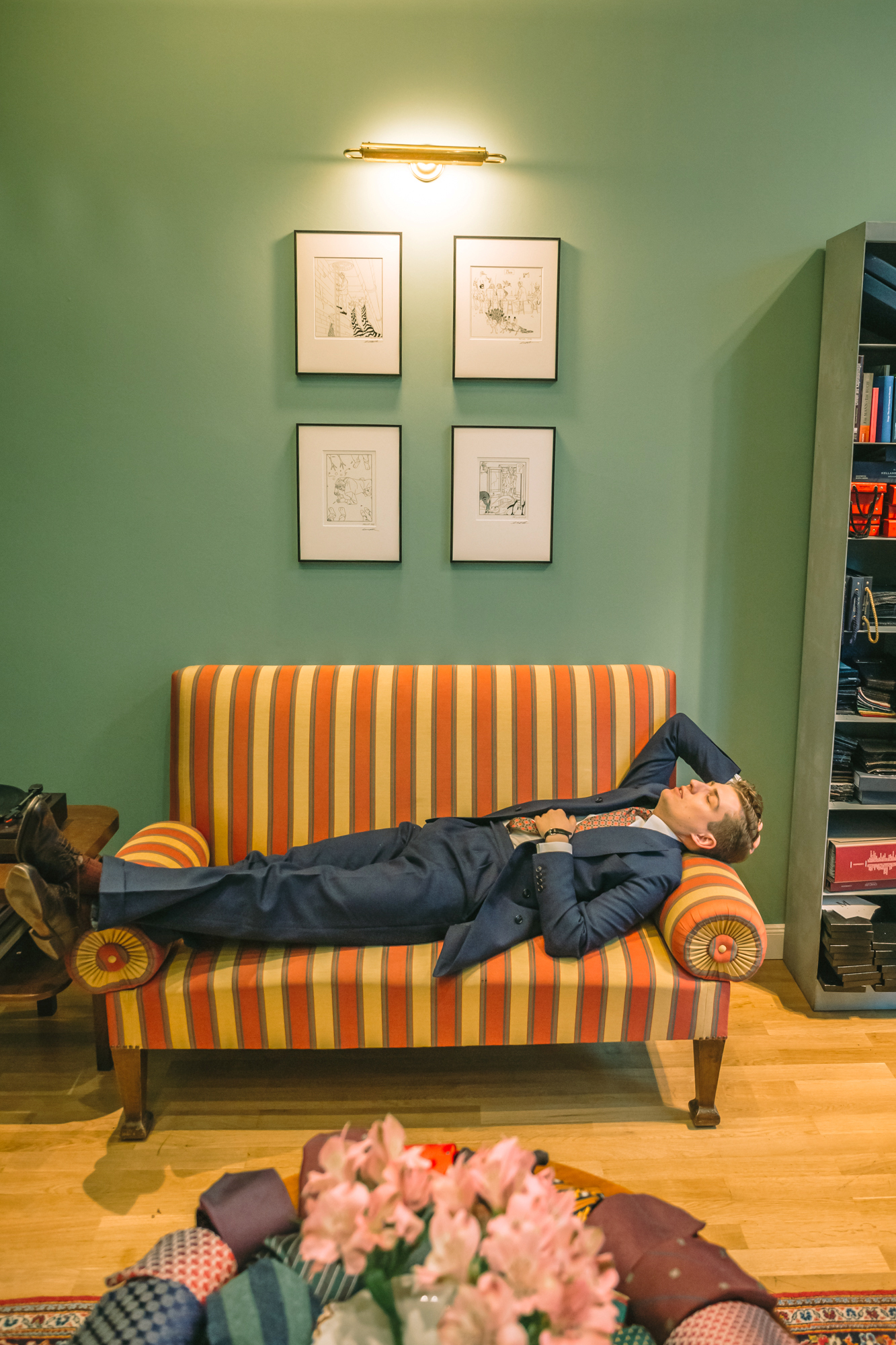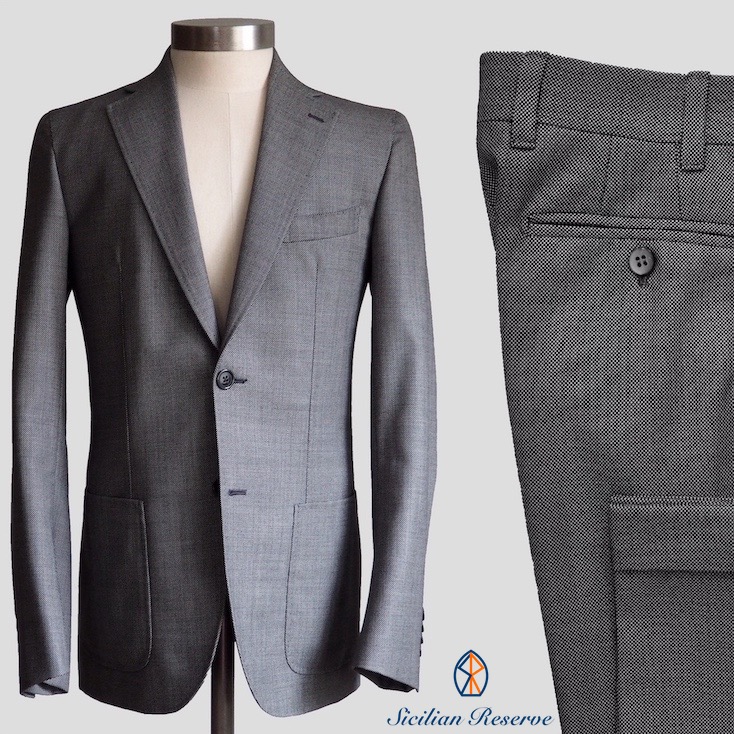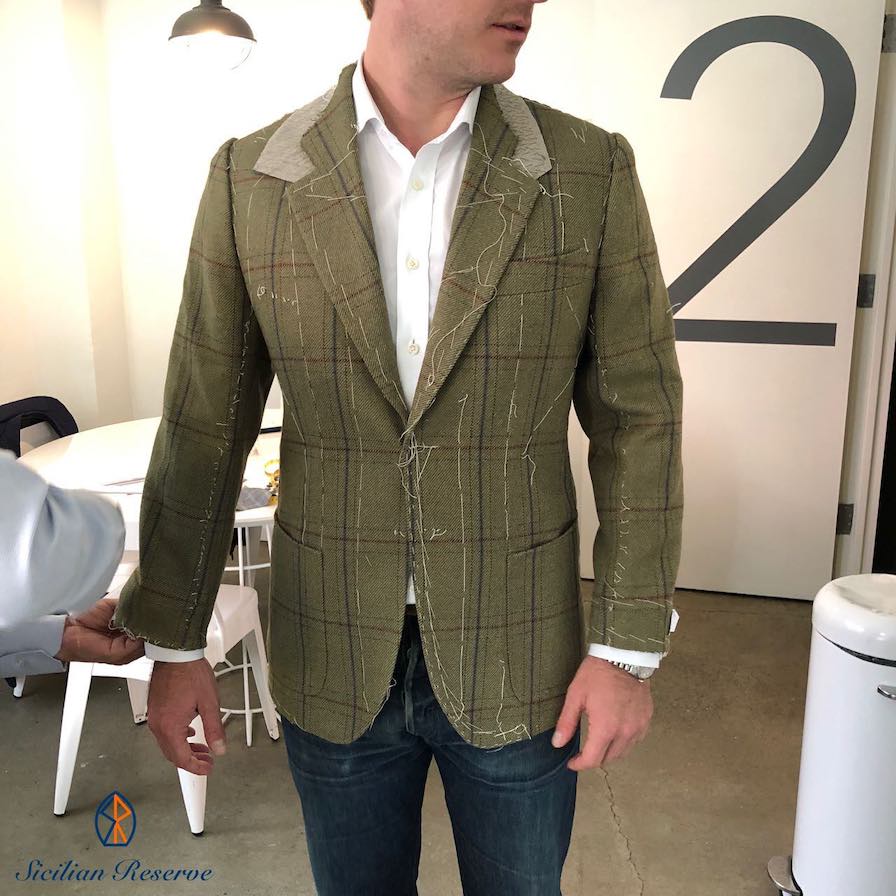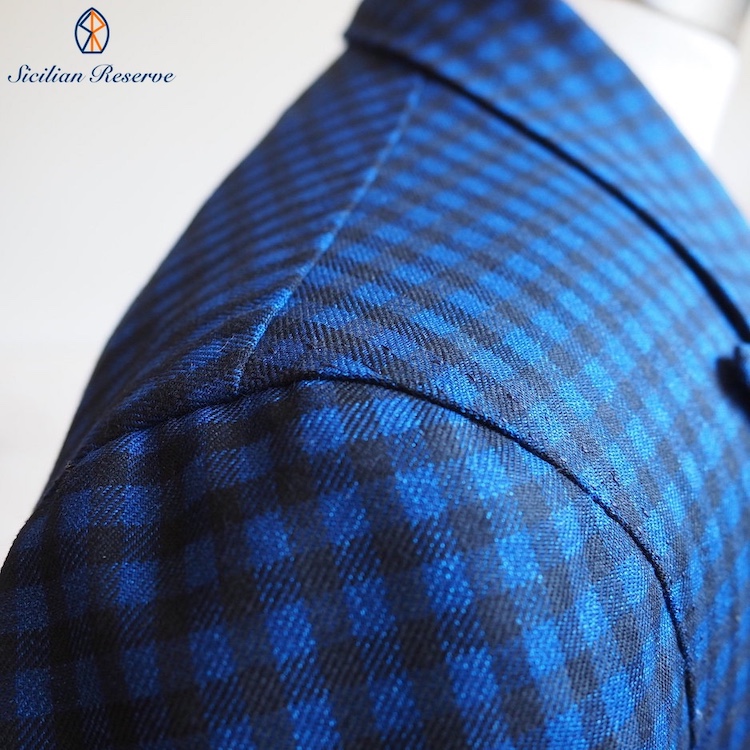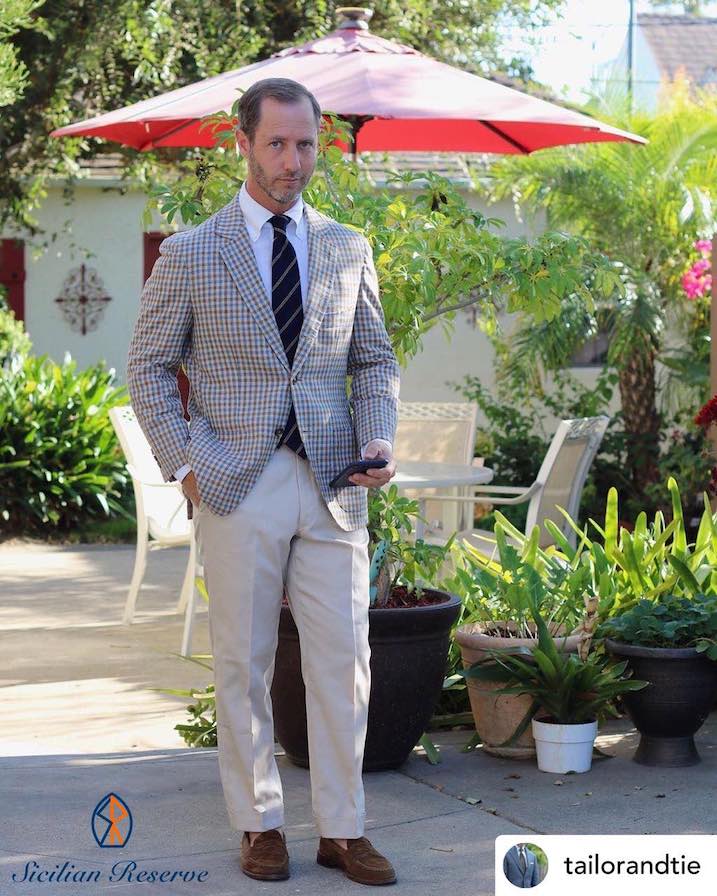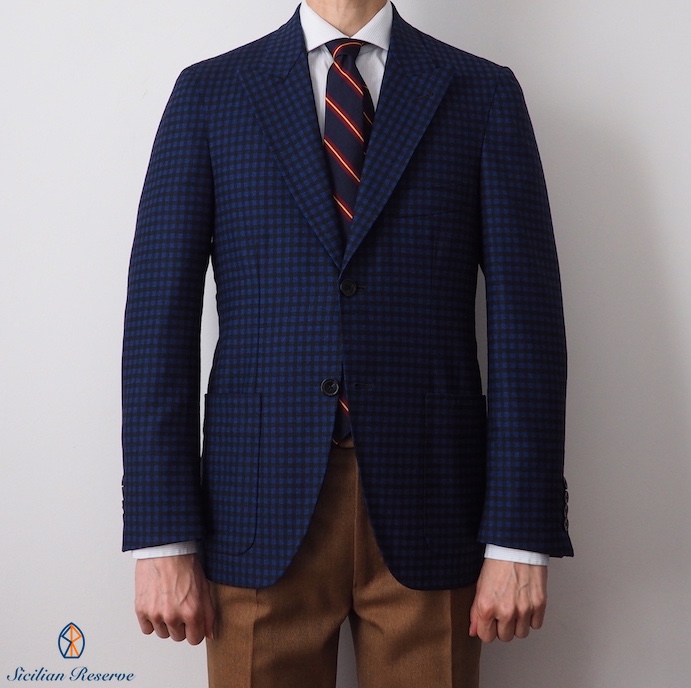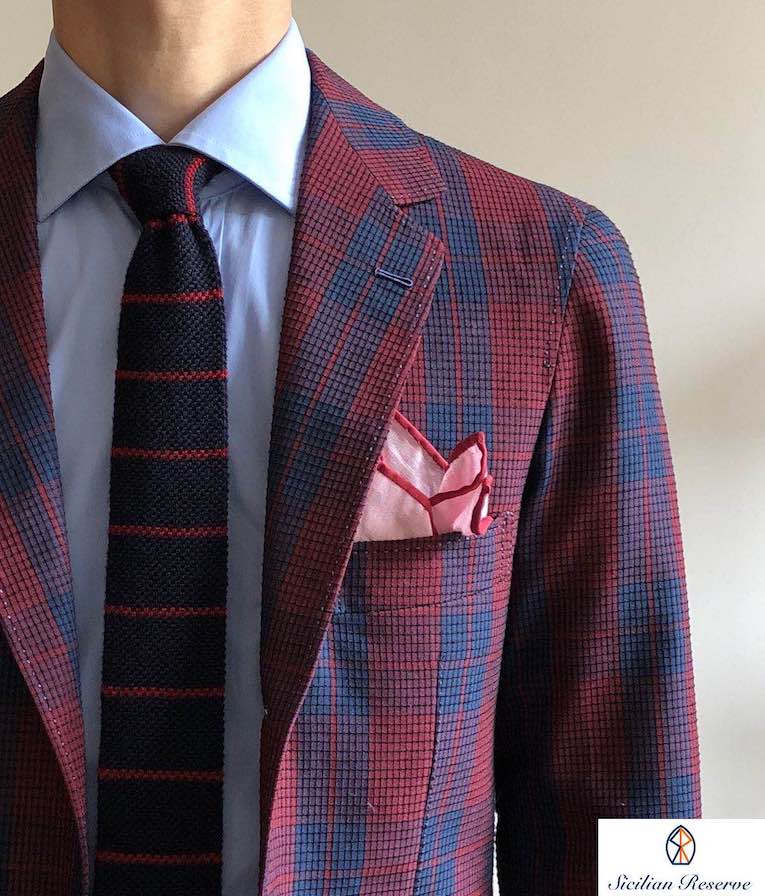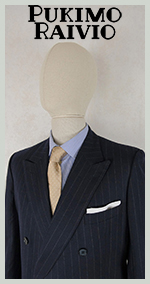Anatomy of Carlos Santos Shoes
0October 23, 2019 by Ville Raivio
Carlos Santos is a Portuguese shoe factory that was founded in 1942. Santos himself began the gentle craft of shoemaking, aged 14, at Zarco, a factory he was able to buy for himself in 2002. The factory is in São João da Madeira, a town known in Portugal as Capital do Calçado, capital of shoes, as the area has a concentration of shoemaking similar to Northampton in England. After purchasing the premises, his name began to appear on the factory’s pairs. Still, at the beginning at Zarco, he helped out at accounting but was not pleased to work with papers. When there was time enough, the young Carlos slipped away from the offices to visit the packing area or the factory floor to gaze at shoes. It turned out that designing and making shoes was the thing.
Today the maker is specialised in Goodyear-welted men’s footwear as well as patinas developed in-house. Their less expensive pairs have Blake-stitched soles. For the latter, CS uses crust leathers which are dyed from scratch. Carlos Santos was not very well-known up until the 2010s, when the maker began to reach more retailers and was marketed better. CS previously concentrated on well-priced men’s shoes for other companies, made at the Santos factory in Portugal but marked with the names of others. The factory favours French and Italian calfskins for uppers, and the designs are classic but there’s also room for experimentation. CS pairs have leather insoles, full cork fillers, leather board heel stiffeners, celastic toe stiffeners in their regular lineup. Today Carlos Santos produces over 70 000 pairs of shoes each year, most of them private label work for client companies.
Today’s example pair is The Wyer model, a clean cap toe derby boot which sports the Braga patina developed by Santos — and it really is the highlight. I call the design clean as there are no exceptions from the lines of a classic cap toe boot, and the proportions of the pieces are swell. Coming to think of it, the plain design only highlights the patina better. The Braga colouring is dark brown at the tip of the toe, medium brown around stitching, and mottled, light brown elsewhere. It looks superb and interesting. Only time will tell how the colours age and how they stay in the leather, though.
As part of the Carlos Santos service, retailers can have their pairs made up how they like. In Pediwear’s case, the boots have rubber soles along with the patina, and the oddly named last Z333. The last has a regular round toe, but it has a beautiful sculpted shape that rounds downwards. The edges are shaped roundly as well, but it’s the heel that has the most aggressive shape. The fit of the last is eccentric: the width on the toe is narrow enough to demand half a size larger than what I usually wear, but there is volume elsewhere so the sock must be a thicker one. The shape of the boot is more on the casual than dressy side.
The stitching is clean, the finish good, and I must also mention the pull tab. It’s the best one I’ve handled: it quickly returns to its upward shape, doesn’t have ugly logos, and feel smooth and firm. Too many factories overlook the humble pull tab! The speed hooks have been treated to look somewhat worn, and the boots arrive with a bright factory polish. The one thing I would change in this pair is the width of the welt, which is on the wider side. If it only were narrower, the front part of the boots wouldn’t look so heavy, and the 360-degree welt also makes the heel look wider. All in all, Carlos Santos is among my favourites in the + 300 euro price range. I hold this opinion after having tried other Santos shoes as well in store. The factory offers beautiful patinas, clean designs, and handsome lasts which combine to make their shoes look more expensive than they are.
Category Footwear, Quality makers
An Interview with Maximilian Mogg
1October 7, 2019 by Ville Raivio
VR: Your age and occupation?
MM: I am 26 years old and I am founder of my own eponymous MTM atelier. We’re also working on offering bespoke in the near future.
VR: Your educational background?
MM: I started with business, before shifting my focus to brand management during by studies in the United States, Germany, and France.
Vr: Have you any children or spouse (and how do they relate to your clothing enthusiasm)?
None that know how to find me.
VR: …and your parents and siblings’ reactions back when you were younger?
MM: We have one golden rule in our family. If you’re doing something (whatever it is) with real passion, the whole family will support you. My father, in particular, always taught us that if you lack passion, you can never be at your best. You just won’t go the extra mile. So, from a very early age, they’ve always supported my choices. When it comes to clothing, I sometimes think that they maybe should have taken me aside and had a word with me. I recall a particular pair of very tight fire-engine-red jeans that left very little to the imagination. Although, ultimately, I think those experiences contributed to my very conservative dress nowadays.
The Mogg team, featuring shoemaker Kahlcke
VR: What other hobbies or passions do you have besides apparel?
MM: I was a high-level sabre fencer for years. I was in the Germany national team, actually. That was really my main focus in life for a long time and clothing was my hobby. That has obviously flipped over time. Other than that, I have a thing for ’80s music, I write about menswear and other topics, and I love drawing.
VR: How did you first become interested in style, and when did you turn your eyes towards more classic pieces? Why these instead of fast fashion?
MM: Fashion generally and the aesthetics associated with it, in particular, fascinated me from a very young age. I can’t really say what the actual trigger was, I simply cannot remember a day when appearance and the act of communication that takes place through clothing was not important to me. I feel that the aesthetics are ultimately secondary to the respect and politeness that a certain way of dressing conveys.
With regards to the second part of that question, the enthusiasm of my early teens for cyclical fashion quickly waned because I disliked the idea of feeling pressured to follow trends. So I did what anyone would probably do. I looked for alternatives and the rest, as they say, is history. I started with classic films, did some research, developed a love for classic English style. That led me to Savile Row, and to high-quality suits. These suits have managed to stand the test of time, give their wearers a means of expressing themselves non-verbally, of dressing sustainably (a high-quality suit can last you a lifetime), of showing erudition, and of covering up their physical flaws.
VR: How have you gathered your knowledge of the tailored look — from books, talks with salesmen or somewhere else?
MM: It all started with books. Reading, reading, reading. We actually have my whole library in the shop and we lend out books to customers if they want to read up on something. From there, I transitioned to writing. I went to Savile Row and interviewed any tailors that I could get my hands on for my blog. This brought me into contact with – in my eyes – some of the best-dressed men in the world. I like to think I learned from every single one of them.
VR: When did you decide to set up your own clothing company, and what goals did you set for yourself in the beginning?
MM: I suppose it all started, as so many things do, with a huge disappointment. My employer at the time called me into her office for a performance review and I still remember the exact phrase: ‘I just don’t believe that you possess an entrepreneurial spirit.’ That was a real slap in the face for me. However, I took that as an invitation to prove her wrong. I haven’t looked back since. My first goal was to make sure that I was making my own decisions, trusting myself, and doing what I love. Everything else has developed from there. When I made the decision to have my name on the products, it became clear to me that I would never compromise on quality.
VR: What’s your style or cut philosophy behind the clothing?
MM: It all starts with one basic assumption. For me, only classic suits, coats, and jackets can sculpt the wearer’s body, communicate formality in a highly-conventionalised way, and be practical at the same time. Our style and cut have to fulfill those three goals.
VR: I trust the “young foolish man” on your site’s story is you. If this is true, why did vintage clothing make such an impression on you?
MM: I can neither confirm nor deny your hypothesis regarding that foolish young man. I can only speak for myself. And, for me, vintage Savile Row suits struck me as being as near timeless in style as something can be and I love the idea of a piece being so well-made that you can pass it on to the next generation. That’s also where my slogan comes from: “My children should wear it, my grandchildren should be inspired by it.”
VR: How would you describe the “House Style” of Maximilian Mogg?
MM: Our house style (which we generally refer to as ‘Deco Drape’) has various inspirations. From the very beginning, Savile Row has fascinated me (It’s still surreal to me that we now regularly host our own trunk shows on the Row). A real game-changer for me was when I was lucky enough to work with Edward Sexton and with his creative director Dominic Sebag-Montefiore, both of whom are great style role models of mine, and purveyors of an incredibly elegant and masculine aesthetic. London and my experiences there were a valuable starting point for our aesthetic.
That being said, there is a secondary reason why British tailoring makes more sense for us. I think the average German/Central European physique is going to be closer to the British than to the average Italian physique, for example. British suits were designed around that physique and, as such, just serve that body type better. The same goes for fabrics. That is why we favour heavier English fabrics (330 g/m and upwards). They are generally more durable (I’ve used vintage fabrics that were thirty years old!), drape better, and fit the weather in Germany better.
Finally, the Art Déco period and its classic, masculine elegance is another major source of inspiration. This is most clearly reflected in the shape of our lapels and in our signature Zee Jerman shirt collar.
The idea behind our house style is to elongate the wearer’s silhouette and make them appear more athletic. The elongating effect is achieved through various means. We cut the armholes very high (and the sleeves relatively slim), have the overall fit through the body slim but never tight (there should never be any signs of pulling), and cut the back as narrow as possible without restricting movement. This creates an hourglass shape through the body. Then, we give our wide-legged trousers a very high rise, and make sure our jackets are long enough to cover the fork of the trousers. This creates a sort of optical illusion, whereby it looks like the legs never end.
To give the wearer a more athletic look, we cut our roped shoulders a little wider than the natural shoulder line and the chest a bit fuller. Our wide and full-bellied lapels put further emphasis on that broad chest.
The final touch is the button stance, which is relatively low (around the natural waist) and accentuates the narrowest point of the wearer’s body. This is key to making the contrasting elements work together.
VR: Who or what inspires you?
MM: People who are following their dreams.
VR: What’s your definition of style?
MM: Authenticity.
Featuring drawings by M.M.
Category Interviews, Quality Stores, Tradesmen
An Interview with Juhn Maing from Sleevehead
0September 21, 2019 by Ville Raivio
VR: Your age and occupation?
JM: I have been a consultant, entrepreneur and technology advisor. Perhaps the best way to describe myself today is that I am a writer and entrepreneur in my 40s interested in menswear, luxury and technology, as well as a lifelong learner and student.
VR: Your educational background?
JM: I am very fortunate in having had a nexus of wonderful teachers, institutions and opportunities starting from first grade in elementary school and continuing through secondary, undergraduate and graduate school. This has helped me to explore interests across a variety of disciplines and fields, mostly in the liberal arts but also in diverse technical or applied fields like computer science and textile science. I think everything started with my parents’ decision to enroll me in Punahou School in sixth grade – perhaps one of the best decisions they ever made at least from my perspective. From sixth grade to the end of high school, I found Punahou’s teachers, campus, students and staff to be very special. My experience there continues to shape how I think and act, especially the wonderful faculty who spurred on and encouraged my interests in writing and the humanities.
As an undergraduate student, I studied literature, history, philosophy, political science, religion and German at Stanford University. At the graduate level, I continued my studies in political science, social science and methodology (e.g. statistics, linear methods) at the University of Chicago. True to its reputation, my UC experience was a particularly intense learning experience. Two classes in particular – data analysis and linear methods (e.g. regression models) – defined my UC education and indelibly shaped my ability to think and write critically, narratively and cogently.
While working in technology, I enrolled in evening classes at the Fashion Institute of Technology (FIT) in menswear, sewing, production, pattern making, textile science and textile quality management. As a side note, one of the most difficult things I’ve ever done was learning how to sew at FIT. But well worth it! As I’ve written elsewhere, there are certain insights you can only gain by becoming a maker or at least learning to become a maker. Without this experience, I think I would have far less interesting things to say about artisans and craftsmanship.
Most recently I enrolled in a specialized master’s degree in luxury brand management at ESSEC Business School to gain insight in the luxury sector. I truly believe in the benefits of lifelong learning and the attitude that goes with it. If you maintain an open, ready mind at all stages in life, you’ll not only grow and develop but you might also discover, create or launch a novel idea, product, company, connect with new friends and like-minded people, etc.
Looking back, my most influential classes come easily to mind. At Stanford, Rene Girard’s seminar on Heidegger was a master class on how to approach and interpret a text persuasively through a lens, Robert Greer Cohn’s courses on French literature taught me that reading literature is both systematic and intuitive, Paul Robinson’s class on European history enabled me to write with empathy on the imagined and actual worlds found throughout history. At the University of Chicago, Mark Hansen’s classes on data analysis and linear methods were like “shock therapy” in rigorous thinking and analysis. At FIT, Robert Rand’s fundamentals of textiles class was a revelation because it opened up the complex, multidisciplinary and fascinating world of textiles.
VR: Have you any children or spouse (and how do they relate to your style enthusiasm)?
JM: I have neither. So I think it’s fair to say that I can blame only myself for what I wear and I find interesting in menswear, fashion, style and design!
VR: …and your parents and siblings’ reactions back when your interest began?
JM: They have taken a mild interest in my pursuits but thankfully have not impeded me in any way. It helps that we all have different interests.
VR: What other hobbies or passions do you have besides apparel?
JM: Besides writing and menswear, I have had a lifelong interest in music – mostly listening and appreciation rather than playing or performing. While I enjoy live performances and concerts, my initial interest as a child began in recorded music. Until the advent of digital/streaming music I regularly collected CDs and LPs in classical, pop/rock and jazz. I still prefer analog music on physical media or high res digital files, and have not yet signed up for streaming services like Spotify or Apple Music. These are undoubtedly convenient and affordable but I still find that the music I enjoy the most is not fed to me but rather the result of my own intentional browsing and exploration.
I am also an avid reader of short and long form content. I have been a subscriber to The New Yorker for more than 25 years and recently began subscribing to The Economist. I look to The New Yorker for current perspectives on society, culture, literature and the arts and to the Economist for politics, business and current events. Both adhere to a level of excellence in writing, journalism and content creation that is harder and harder to find these days. Another interest is travel but not simply to “collect experiences” for myself but rather as a way to discover and draw connections between people, places and things.
VR: How did you first become interested in style, and when did you turn your eyes towards the classics?
JM: As I noted in the July 2019 Stanford Magazine feature on Sicilian tailoring, I became interested in style out of personal and professional necessity. Admittedly, this is par for course for anyone who works in an office and/or meets customers. But my particular body sizing made it very difficult for me to find anything that fit me off-the-rack. Hence my journey started in RTW, progressed through MTM and ended up in bespoke tailoring. And I started with classic menswear since that was and should be the natural starting point for anyone who needs to dress in a professional setting.
VR: How have you gathered your knowledge of the tailored look — from books, talks with salesmen or somewhere else?
JM: Initially, I learned about the tailored look from all of the above sources you mentioned. I would add online sources as well. But my breakthrough did not come from speaking with salespeople or reading a book. As I described above in my educational background, there is a crucial aspect to artisanal work like tailoring that cannot be truly understood unless you become a maker yourself or learn to become one. My glimpse into this world was invaluable and very instructive because I learned why things are done in a certain way (as opposed to vaguely being aware that such things are done). It helped me ask the right questions and appreciate the critical elements of men’s tailoring both as a customer and as someone who writes on men’s tailoring.
VR: How would you describe your personal style?
JM: I find that my sense of style is a living, adaptive process rather than a fixed tradition or canon. I know for many men classic style is a fixed thing – it’s about following traditional rules of dress. But for others, it’s the complete opposite. Neither fully captures my style. On the one hand, I am certainly aware of sartorial traditions and “rules.” But I also dress for the situation and context I find myself in, which invariably change with the time and place. Perhaps my style can be described by two well-known dictums – “know thyself” and “nothing in excess”. My style is about balancing the contrasts in life – following the rules v. knowing myself, discipline v. imagination, constancy v. change.
VR: Among so many companies you’ve tried, which artisans or RTW makers do you favour today — and why these?
JM: Great question and well-timed! I actually blogged very recently about 10 brands (or makers) to know based on my personal experience as a normal customer. The list is not exhaustive and I’ll undoubtedly add to it in the future but it is a good place to start.
VR: Have you any particular style or cut philosophy behind the clothes you’ve commissioned?
JM: There is a definite spectrum in terms of men’s tailoring from structured to unstructured. In fact, it’s possible to category every tailor on this spectrum. (I should note that at least two dimensions are needed to create a proper tailoring framework but this is a good approximation). I have tried both structured and unstructured and everything in between, including Savile Row, Neapolitan, Sicilian, American, Hong Kong, and Southeast Asian tailoring. Bespoke tailoring can attract very decided adherents of one cut or another. I don’t think one particular cut or tailoring strategy “rules them all”. Having said that, I find that I find Sicilian tailoring offers an especially pleasing, harmonious blend of structured and unstructured tailoring that works well for many people.
VR: You’ve been blogging for over 10 years now. How was Sleevehead first born and what were your goals in the beginning?
JM: I started blogging in 2005 so it’s nearly 15 years actually. I’m afraid there is no remarkable origin story apart from a few things that coalesced. For one thing, I enjoy writing. In the early days of the web, I did not find much online in terms of blogs and other content on menswear and/or with point of view that was interesting to me. Since Blogger was free, I decided to start blogging myself. I did not have any goals per se apart from just writing about topics and experiences that were interesting to me and I thought might be interesting to others.
VR: Did readers request you to write up Sleevehead’s Guide to Sicilian Tailors, or how did the book come about?
JM: For better or worse, the original idea for the book was something I realized on my own. I knew I needed to share what I discovered about Sicilian tailoring and was thinking about possible options. One option was posting what I discovered on a well-known discussion forum. This was something I was somewhat seriously considering. It required the least effort and offered the path of least resistance. In hindsight, I am very, very glad I refrained from committing what would have been an act of self-immolating altruism! If the reasons against freely sharing on a third-party platform are not apparent, they should become much clearer if you think about the time and money (think hundreds of hours, multiple bespoke commissions and multiple roundtrip transatlantic airfares) that made the discovery possible.
The other option was simply blogging about it, attracting an audience and then placing display ads to monetize the content. That was also not particularly appealing to me (though from a purely financial perspective something I probably should have chosen this option). In the end I chose to share the discovery through traditional long-form content (i.e. a book) which does both justice to the topic and provided my own platform and audience that was helpful later on (see the question below on Sicilian Reserve). In the process I also learned how to to self-publish a book including all the essential pieces of the puzzle such as graphic design, copyediting, proofreading, photography, etc. Another valuable learning experience.
VR: Who or what inspires you?
JM: I’m inspired by anyone, anything or any spirit that enlivens and enlightens our world. This is something I wrote in the dedication to the second edition of my guidebook. There is no limit to the people, places, sights, sounds, things or ideas that can inspire. But the odd thing about inspiration is that it can be both rare and plentiful. The key is the willingness and openness to search for it. The social theorist Gramsci has a wonderful, double-sided phrase for this and much else in human affairs – “pessimism of the intellect, optimism of the will”. Willful optimism led me to discover and explore the world of Sicilian tailoring. However, there is a fine line between being inspired and simply following. If I had just followed what I read online or what others were doing, I would have stopped my search long ago at the well-known tailors in London, Paris, New York, Milan, Rome and Naples. I never would have discovered Sicilian tailoring which I regard as the third pillar of heritage bespoke.
VR: What’s your definition of style?
JM: This is a perfect segue to my next book which will be on masculine style (the working title is “Sartorial Personae: Understanding Masculine Style”). Curiously, the problem with style is that everyone has their specific, almost hermetically sealed take on it. Generally, there are two approaches to defining style. One is about timelessness, elegance, etc that only a select few have access to. It’s a binary selection – you either have it or you don’t. The other is simply “expressing or being yourself” which quickly becomes solipsistic and ungeneralizable because it is so personal or subjective. Both approaches oversimplify and are not especially helpful. In the end, I find that style is rarely just one thing or one dimensional. In my view, having a distinctive style usually means an interplay of different things. For example, what makes style distinctive is often that it can be both familiar (consonant) and unfamiliar (dissonant), neither too familiar (cliche) nor too unfamiliar (strange). I’ll unpack what this means concretely by looking at male style icons from the past and present. With this book I wish to cut through the clutter and provide some interesting, yet actionable content on what has been a rather slippery, elusive and poetized topic.
VR: Finally, you now have your own company, Sicilian Reserve, set up. How does your service work and why should my readers try you out?
JM: With Sicilian Reserve, I work with Sicilian tailors to connect them to customers in the US and elsewhere. We currently meet customers in New York City and the Bay Area/San Francisco and are open to visiting other cities depending on interest level. As my readers and customers know, I truly regard Sicilian tailoring as the last secret left in heritage bespoke tailoring, i.e. a tailoring strategy with a history, critical mass and provenance. This is also why I continue to make the case and spread the word on these remarkable tailors. Many thanks for the opportunity to share my thoughts.
Category Bloggers, Interviews, Italian Style, Tailors, Tradesmen, Web stores, Writers
At the Enzo Bonafé Factory
0September 21, 2019 by Ville Raivio
Category Footwear, Quality makers, Videos
Copyright © 2013 Ville Raivio

